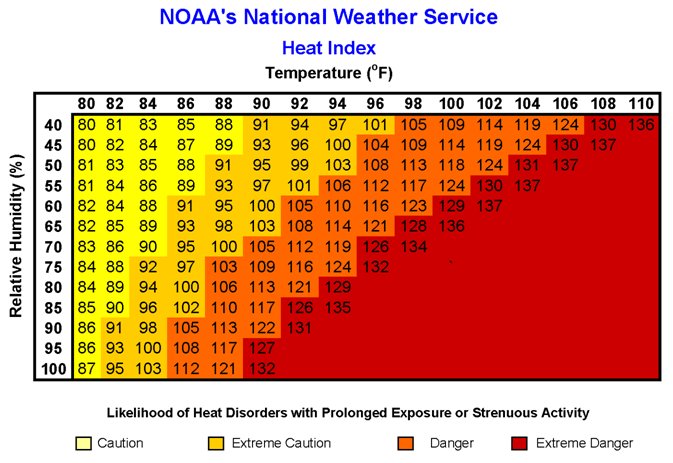Hypothermia and Heat Stress & Ways to
Prevent Them
1. Cold Weather - Great reference is the National Center for Cold Water Safety
In the past there was the "100 Rule" and then along came the "120 Rule" which in a simplistic way tried to alert paddlers to environmental conditions that posed much higher risk. Those old Rules are flawed (if the sum of air and water temp is less than x then do y) and the risk of environmental danger deserves more dialog than are found in a catchy Rules definition.
Hopefully you'll take the time to explore the Cold Water Safety website linked above. A wealth of knowledge to be found there but at least take the time to review the section on "Five Golden Rules".
2. Hot Weather - The 103 Rule of Thumb:
When the heat index is more than 103, you are in danger of heat stress (see heat index chart below). Because high humidity magnifies the effect of high temperature on us, weathermen often call this a "feels like" temperature. The heat index values are developed for shady, light wind conditions. Exposure to full sunshine can increase the Heat Index dramatically. The National Weather Service recommends "extreme caution" when the Heat Index range of 91 to 103 and to be aware of heat stress "danger" in the range of 103-124.
If you would like to determine the heat index for a planned paddle you can find the information at:
· Daily heat index information at WeatherForYou.com (scroll down to forecast details)
https://www.weatherforyou.com/report/tampa-fl
· The National Weather Service issues a weekly prediction of the heat index here:
https://www.wpc.ncep.noaa.gov/heat_index.shtml
Overheating can quickly progress to heat exhaustion and/or heat stroke which can cause serious injury or death. Contrary to popular belief simply maintaining adequate hydration and electrolytes will not preclude a heat illness accident. Experience has shown that if all four of the following conditions are present, a high potential for onset of heat illness exists.
- a. High Air Temperature (88 degrees and above)
- b. High Humidity (80% and above - it feels "muggy")
- c. Low Wind (5 knots or less)
- d. High Water Temperature (86 degrees and above)
If all four of the above conditions are present, or anticipated during a kayak trip, trip leaders should consider cancelling the trip or taking the following precautions:
- · Plan trips earlier in the day.
- · Stop frequently for water breaks and check that all have and use adequate hydration and electrolytes.
- · Reduce trip distance and paddle speed.
- · Avoid getting caught in open water, remote locations, or other situations where rescue would be difficult.
- · Avoid long downwind legs on a hot day.
- · Avoid the “doldrums” typically found adjacent to building storms and/ or in the transition period between the morning breeze and the afternoon sea breeze.
Symptoms of heat stress include; profuse sweating, headache, pale or red skin, nausea, muscle cramps, weakness, dizziness, lose of coordination, and many others. Once a participant starts to succumb to heat illness, it will be very difficult to cool the victim down and reverse the process. Towing a victim will hazard the rescuers to overheating.
If you, or anyone else in your group, have symptoms of heat stress, it's essential to
immediately get out of the heat and rest. If you can't get inside:
- Find the nearest cool and shady place and have the victim lie down
· Remove any tight or unnecessary clothing
· Have the victim drink plenty of fluid (avoid caffeine and alcohol)
- Pour water over him/her to aid in the cooling process
- Seek medical help
